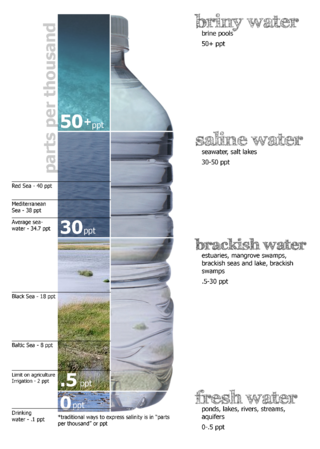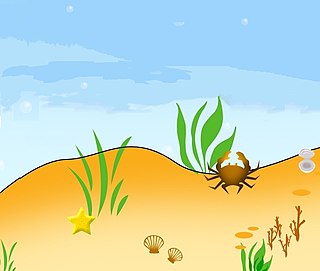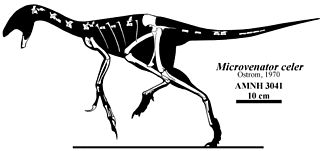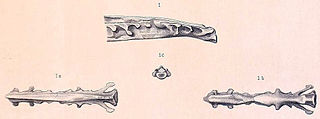
Brackish water, sometimes termed brack water, is water occurring in a natural environment that has more salinity than freshwater, but not as much as seawater. It may result from mixing seawater and fresh water together, as in estuaries, or it may occur in brackish fossil aquifers. The word comes from the Middle Dutch root brak. Certain human activities can produce brackish water, in particular civil engineering projects such as dikes and the flooding of coastal marshland to produce brackish water pools for freshwater prawn farming. Brackish water is also the primary waste product of the salinity gradient power process. Because brackish water is hostile to the growth of most terrestrial plant species, without appropriate management it is damaging to the environment.

The Mediterranean Sea is a sea connected to the Atlantic Ocean, surrounded by the Mediterranean Basin and almost completely enclosed by land: on the north by Southern Europe and Anatolia, on the south by North Africa, and on the east by the Levant. The Mediterranean has played a central role in the history of Western civilization. Geological evidence indicates that around 5.9 million years ago, the Mediterranean was cut off from the Atlantic and was partly or completely desiccated over a period of some 600,000 years during the Messinian salinity crisis before being refilled by the Zanclean flood about 5.3 million years ago.

Benthos, also known as benthon, is the community of organisms that live on, in, or near the bottom of a sea, river, lake, or stream, also known as the benthic zone. This community lives in or near marine or freshwater sedimentary environments, from tidal pools along the foreshore, out to the continental shelf, and then down to the abyssal depths.

The Aral Sea was an endorheic lake lying between Kazakhstan in the north and Uzbekistan in the south which began shrinking in the 1960s and had largely dried up by the 2010s. The name roughly translates as "Sea of Islands", referring to over 1,100 islands that had dotted its waters. In the Mongolic and Turkic languages, aral means "island, archipelago". The Aral Sea drainage basin encompasses Uzbekistan and parts of Tajikistan, Turkmenistan, Kyrgyzstan, Kazakhstan, Afghanistan, and Iran.

Marine reptiles are reptiles which have become secondarily adapted for an aquatic or semiaquatic life in a marine environment.

The Pampas deer is a species of deer that live in the grasslands of South America at low elevations. They are known as veado-campeiro in Portuguese and as venado or gama in Spanish. It is the only species in the genus Ozotoceros.

Microvenator is a genus of dinosaur from the Early Cretaceous Cloverly Formation in what is now south central Montana. Microvenator was an oviraptorosaurian theropod. The holotype fossil is an incomplete skeleton, most likely a juvenile with a length of 1.3 m (4.3 ft), and consequently, the adult size remains uncertain. Microvenator celer is primitive and may be the "sister taxon to all other oviraptorosaurs."

Apatornis is a genus of prehistoric birds endemic to North America during the late Cretaceous. It currently contains a single species, Apatornis celer, which lived around the Santonian-Campanian boundary, dated to about 83.5 million years ago. The remains of this species were found in the Smoky Hill Chalk of the Niobrara Formation in Kansas, United States. It is known from a single fossil specimen: a synsacrum, the fused series of vertebrae over the hips.
Thermococcus celer is a Gram-negative, spherical-shaped archaeon of the genus Thermococcus. The discovery of T. celer played an important role in rerooting the tree of life when T. celer was found to be more closely related to methanogenic Archaea than to other phenotypically similar thermophilic species. T. celer was the first archaeon discovered to house a circularized genome. Several type strains of T. celer have been identified: Vu13, ATCC 35543, and DSM 2476.
Flavius Celer was a Byzantine general and magister officiorum under Emperor Anastasius in the early 6th century.
Celer was an American drone music project formed in 2005 by composer and musician Will Long and Danielle Baquet-Long, and concluded in 2022.
Grimontia hollisae is a species of Grimontia proteobacteria, and is the only pathogenic species that does not grow on thiosulfate-citrate-bile salts-sucrose agar (TCBS). Based on phylogenetic evidence, the species was reclassified in 2003 from Vibrio hollisae.
Iaceornis is a prehistoric marine bird genus endemic to North America during the Late Cretaceous living about 83.5 mya. It is known from a single fossil specimen found in Gove County, Kansas (USA), and consisting of a partial skeleton lacking a skull.
Psychrobacter celer is a Gram-negative, slightly halophilic, non-spore-forming, nonmotile bacterium of the genus Psychrobacter, which was isolated from the South Sea in Korea.

Mecaphesa celer, known generally as the swift crab spider, is a species of crab spider in the family Thomisidae. Its range is quite large, and it is found throughout much of North and Central America.
Microbulbifer celer is a Gram-negative, rod-shaped and non-motile bacterium from the genus of Microbulbifer which has been isolated from a marine solar saltern from the Yellow Sea in Korea.
Grimontia is a genus of bacteria from the family of Vibrionaceae.
Grimontia indica is a Gram-negative, rod-shaped and facultative aerobic bacterium species from the genus of Grimontia which has been isolated from Seawater from the southeast coast of the Palk Bay.








